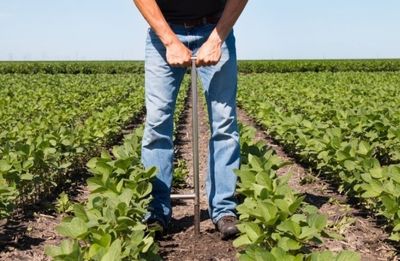 A soil probe is commonly used to aquire soil nutrient samples.
A soil probe is commonly used to aquire soil nutrient samples.
- Accurate soil sample results are a critical component of a grower’s fertility management program.
- Potassium and other nutrients may be detected at lower-than-expected levels if dry soils are sampled.
- Wait for a rain event before sampling to reduce potential issues.
Many areas of the FS System have experienced prolonged drought conditions at some point this year. In these scenarios, we need to be cautious when pulling soil samples. Dry soils can affect soil test results and results in inaccurate results. This article discusses the issues that may be encountered in these situations.
Issues with soil collection
In dry conditions, it can be difficult to collect a complete sample. Most states in the FS System base fertility recommendations on a 6-9-inch-deep soil core. If the soil is too dry, it can be difficult to get a sample to those depths that will hold together. It is critical to get a good sample as the tests we perform need to have that entire column of soil to account for nutrient stratification. This issue can be somewhat overcome by using an auger or slide hammer to collect samples, or simply waiting until a rain occurs.
Problems with pH
Nutrient availability is strongly impacted by soil pH. In a dry soil, pH readings can be 0.1-1.0 lower than a soil with adequate moisture due reduced leaching of some soluble salts. This issue is most problematic is water pH is used to correct pH values. If buffer pH is used to correct soil pH values are more likely to be accurate regardless of soil moisture. Therefore, it is essential that you know what your region uses to determine liming rates. For example, Illinois uses water pH to determine liming rates. As a result, those in Illinois must be aware of the influence of dry soils on sample results, as there is a tendency to over apply lime under these conditions.
Phosphorus (P)
Dry soils have minimal effects on soil P tests. We may see a slightly reduced P value due to the lack of water slowing the processes in the soil that move P from less available sources to more available sources, such as weathering, mineralization, dissolution, and desorption. An additional 7-10 lbs of P2O5 may be gained from leaching of nutrients out of corn stalks after harvest.
Potassium (K)
Sampling for K in a dry soil can have a large effect on the results we are receiving, resulting in lower-than-expected soil test levels. This occurs for three major reasons. The first is the same as the process as above with P moving from less available sources to a more available pool, which requires water and is slower than normal if the soil is dry. The second reason K levels may be lower than expected has to do with clay content. In soils that contain 2:1 clay, the clay may collapse when dry, which traps K. Adequate moisture makes this K available to the plant. The third reason is related to the impact of water on residue. Most K does not bind into other compounds in the plant, it is easily leachable from the residue. Corn and soybean residue can recycle 30-80 lbs of K2O back into the soil from rainfall events primarily after harvest.
Summary
Soil testing is a critical component of any grower’s fertility program. Sampling in dry conditions can result in inaccurate measurement of the soils nutrient levels. Growers will realize a greater ROI when fertilizer recommendations are made from accurate soil tests. This can be ensured if soil sampling is delayed until significant rainfalls have occurred in areas that have been droughty since August 1. In areas that are under severe drought, it may be advisable to use a previous soil test for applications this fall and wait until spring for testing; this will allow for winter snow and rainfall to recharge the soil and provide time for these processes to work.